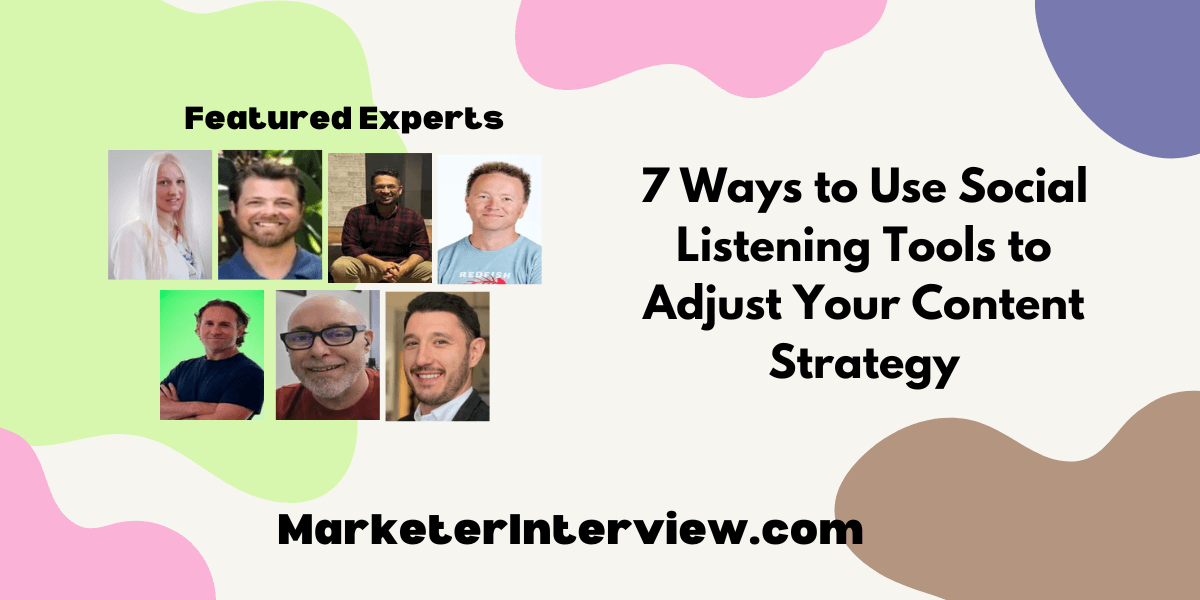7 Ways to Use Social Listening Tools to Adjust Your Content Strategy
In the dynamic world of digital marketing, savvy CEOs and Marketing Managers leverage social listening tools to refine their content strategies. From incorporating interactive content elements to developing detailed buyer personas, explore the seven specific approaches these experts recommend for adjusting your content strategy to the pulse of your audience.
Want to get quoted in MarketerInterview.com content just like this? Apply to become a contributor today!
Contents
Incorporate Interactive Content Elements
Effectively utilizing social listening tools can significantly enhance your content strategy. Start by tracking keywords and mentions related to your industry across social media platforms. At our firm, employing these tools helped us identify a rising demand for interactive content formats such as polls and quizzes. This discovery led us to diversify our content approach, incorporating more interactive elements that encouraged audience participation and feedback. By staying attuned to audience sentiments and preferences, we continually adjust our content strategy to deliver more engaging and relevant experiences, fostering stronger connections and driving meaningful interactions with our community.

Sahil Kakkar, CEO & Founder, RankWatch
Align Content with Audience Trends
When I first started using social listening tools for our small online business, I was overwhelmed by the sheer amount of data. But I quickly realized that one of the most impactful ways to use this information was to identify trending topics and conversations relevant to our target audience. For example, when I noticed a surge in discussions about sustainable fashion on Instagram, I knew it was an opportunity to adjust our content strategy.
I started by creating a series of posts highlighting our eco-friendly products and sharing tips on how to build a sustainable wardrobe. We also partnered with a few influencers who were passionate about sustainability to amplify our message. The response was incredible. We saw a significant increase in engagement on our social media channels, and our website traffic from Instagram skyrocketed.
By staying attuned to these trends, we were able to create content that not only drove engagement but also aligned with our brand values and resonated with our customers on a deeper level.

Liga Rudzite, Marketing Manager, Lemon Pitch
Spy on Competitor Content Gaps
Leveraging social listening to spy on your competitors is a valuable tactic. Tools like Awario or Talkwalker allow you to track what your competitors are doing well and where they’re falling short. By analyzing their content strategy, you can identify gaps in the market that your content can fill. For example, if competitors are overlooking certain topics or failing to engage with their audience on specific platforms, you can capitalize on these opportunities by producing targeted content. This competitive intelligence helps you stay ahead and differentiate your brand in the crowded digital landscape.

Marc Bishop, Director, Wytlabs
Create Targeted Niche Content
Utilizing social listening tools like Hootsuite Insights to monitor conversations about niche topics helps refine content strategy effectively. By tracking keywords related to Edumentors, such as “online education trends” or “e-learning challenges,” we identified gaps in the current content. For instance, noticing frequent mentions of difficulty in engaging remote learners, we created targeted blog posts and videos addressing innovative engagement techniques. This responsive approach ensured our content remained relevant and valuable, boosting audience engagement and satisfaction.

Tornike Asatiani, CEO, Edumentors
Build Profiles from Case Studies
Case studies are key to maximizing social listening techniques. You can’t accurately evaluate all your followers on social media, but you can develop an archetype and build a profile around it by highlighting one or two of your top potential customers or clients.
For example, as a recruiter in the tech industry, I’m looking to attract fresh graduates before they’re contacted by competitors. Building these relationships requires a deeper understanding of youth culture: knowing where these candidates like to hang out, what they enjoy doing, and even their lingo helps me forge a connection when the time comes.
I’m able to use social listening on case study samples to discover what my target audience is interested in, and then take that information and apply it to my own marketing and content strategy. I might take a hot topic and work it into my SEO copy, or relocate my sourcing to the latest app preferred by young tech workers.
A deep dive into just a single archetypal social media account can be incredibly valuable and not overly time-consuming.

Rob Reeves, CEO and President, Redfish Technology
Tailor Content to Trending Topics
I’ve found that using social listening tools to analyze trending topics within my industry has been key in adjusting our content strategy. By monitoring conversations on platforms such as Twitter and LinkedIn, we were able to identify popular hashtags and keywords, allowing us to tailor our content to better resonate with our target audience. This approach led to a 20% increase in engagement and a 15% growth in followings across our social media channels. The key takeaway is to actively listen to what your audience is saying online and use that insight to create relevant and impactful content.

Josh Ladick, President, GSA Focus
Develop Detailed Buyer Personas
Before using social listening, my content strategy was more general and not as targeted toward my ideal customers. However, through monitoring conversations and analyzing data from social media platforms, I was able to identify common characteristics and behaviors of potential home buyers in my area.
Using this information, I created detailed buyer personas that represented different segments of my audience. For example, one persona might be a first-time homebuyer looking for a starter home, while another might be a young professional searching for a luxury apartment.
With these personas in mind, I was able to tailor my content to address their specific needs and pain points. For the first-time homebuyer persona, I focused on creating content that explained the home-buying process step-by-step and provided tips for budgeting and saving for a down payment. For the young professional persona, I shared content about up-and-coming neighborhoods and trendy apartment complexes.
Not only did this targeted approach attract more engagement and conversions from my target audience, but it also helped me better understand their preferences and interests. This allowed me to continually adjust and improve my content strategy to better resonate with my audience.

Robert Fausette, Owner, Revival Homebuyer
Want to get quoted in MarketerInterview.com content just like this? Apply to become a contributor today!






